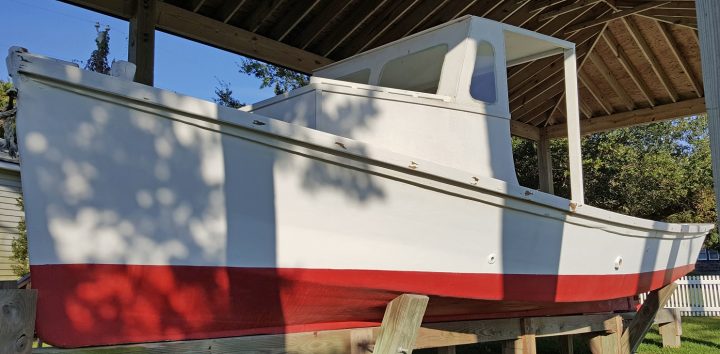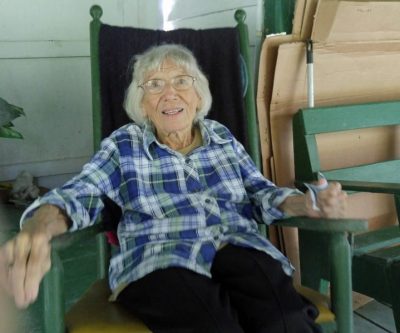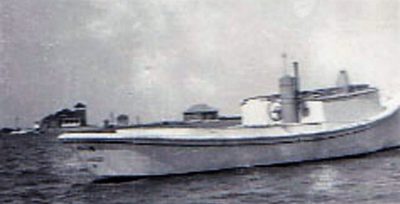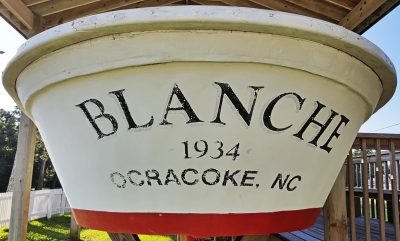
OCRACOKE ISLAND – Blanche Howard Joliff was a young teenager when her father, Stacy Howard, decided in 1934 that he needed another boat. He commissioned a master boatbuilder, Tom O’Neal, to begin building him a fine skiff.
The work was finished by another island boatbuilder, Homer Howard, who added a rounded cabin near the prow. Proud of his well-designed craft – a traditional deadriser with a V-shaped hull at the bow that’s flatter toward the stern – Howard gave it the name of his daughter, Blanche.
Supporter Spotlight

Blanche, who died in April at 98, always remembered how happy she was when her father named the boat for her, and how she loved going fishing with him. She bragged, “One day I caught 57 bluefish, and I thought I had done something.” The boat that carries her name is now an outdoor exhibit at the Ocracoke Preservation Society Museum.
Born in 1919, Blanche was delivered at home by Ocracoke’s renowned midwife, Charlotte “Miss Lot” O’Neal. She lived in her parents’ house on Howard Street until the early 1950s, when she met a young man who was looking to build a highway on the island. Upon their marriage she moved to the mainland, coming back once a month to see her family. After her husband’s death in 1994, Blanche moved back into the home on Howard Street where she grew up, where she stayed until shortly before her death.
Blanche’s father was an island fisherman. Blanche’s mother, Elizabeth Ballance Howard, also born on the island, had family connections to Hatteras Island as well.
Blanche liked to talk about what life was like back then for her and her three sisters, Leila, Etta and Lois, as they were growing up.
“Momma kept chickens,” she once said. “They ran around free, and sometimes they’d get into trouble – scratch up someone’s garden. Sometimes when we were young, Etta and I would chase them around and get them squawking. It was the best fun, but then we’d get in trouble.”
Supporter Spotlight
Her family ate fish, clams, turtle, chicken and vegetables. You couldn’t get fresh meat because there was no refrigeration.
“Papa had a big garden out back, with cabbage, string beans, collards and sweet potatoes. My mother made the best sweet potato pie,” she said.
One of Blanche’s favorite foods was turtle. She recalls that before they were listed as an endangered species, fishermen in the village would catch sea turtles in their nets and bring them back to the fish house at Mace Fulcher’s Community Store. They would quarter them and give each quarter to a family, who parboiled it.
“You had to cook it a good while, ’til it was tender, and then you cut the meat off the bone,” Blanche explained. “You cooked it with onion, potatoes and a little bit of salt pork. We called it turtle hash, and you had to have baked cornbread with it. You never tasted anything so good.”
The foods they did not grow came mostly from Fulcher’s Community Store, but there were other stores on the island, too. Back then, there were two or three fish houses, which also sold big blocks of ice in the days before refrigeration.
Blanche remembered the ponies that wandered around freely in the village. “Sometimes folks would ride them to the store, tying them outside while they shopped.”

Blanche played hopscotch with neighboring children, and they played in make-believe houses and kitchens, using broken dishes and making pretend desserts with red sand. She recalled pretending a piece of cedar was chicken. They also filled the tops of coffee cans with mud, let them dry, and put them together to make pretend layer cakes.
In Blanche’s early years, nearly all transportation was by water.
She recalled, “There were two freight boats, which went to little Washington (in Beaufort County) or Morehead City, and two mailboats, which came out of Beaufort, and after that from Atlantic (in Carteret County).”
Blanche’s uncle had a horse and cart, and he’d give the girls rides.
“Once, when I was about 5, I went out across the beach with my uncle and aunt to see where the ship, the Victoria S, had fetched up on a shoal,” Blanche recalled. “The ship was still in water, loaded with lumber, but it could not get off the shoal.”
The owner of the lumber, she explained, had it unloaded and stacked on the beach. He wanted to get it shipped to the mainland. Two island men got the idea that they would each buy a flatbed truck and haul the lumber from the beach to the docks where it could be shipped.
“But there wasn’t a road the whole way, so they got permission to cut through the oak and myrtle in front of Blanche’s house and make one. It wasn’t very wide, and there was deep sand. In order to get through the sand, they had to gun their engines and try to plow through it fast. One day the two trucks met head-on at the sandy stretch. This was the first road wreck on the island.”
Meanwhile, the boat her father had named for her was put to good use. For nearly 80 years, the Blanche plied the waters around Ocracoke, passing through many owners and uses. In 2006, the Blanche’s most recent owner, James Barrie Gaskill, donated the boat to the Ocracoke Preservation Society, and the work of restoring the skiff and telling its story began.

The Blanche’s history was compiled by talking to islanders and fishermen who remembered and worked on the boat.
Maurice Ballance recalled when Blanche’s father, and his uncle by marriage, had the boat built. He said that Howard used the Blanche to long-haul, a fishing method in which two boats drag a long net to shore and another boat circles around to bail the fish, for trout, spot and sea mullets.
He also did sink-netting in the ocean for bottom fish and, according to Ballance, “One time, Stacy and Murray Spencer, who was fishing with him, like to got swamped coming in. They were running before the sea. A breaker swamped her and she was half-full of water.”
Stacy later took out fishing parties – visitors to the island who wanted a real fishing experience – on the Blanche.
“That boat’s been through a lot,” mused Ballance. “It was wrecked up some during the storm of ’44, when it broke the stake it was tied to in the harbor and went into a piling. Preacher Dixon and I waded out and cut her loose and retied her, but some boards were damaged.”
After Howard died, the Blanche passed through the hands of several owners until Gaskill’s father, Lum Gaskill, took ownership and rechristened it the “Candyjoe” in honor of his grandchildren, Candy and Joe.
Vince O’Neal, who now owns the Pony Island Restaurant, remembered swimming around the Candyjoe when the boat was tied up near Lum Gaskill’s dock.
“Yeah,” admitted Vince, “we snuck up on her sometimes at night when no one was watching and jumped off. We were kids, you know.”

When Lum Gaskill died in 1975, Ballance took the Blanche to Qwawk Hammock, where he planned to use her for long-hauling. There, someone stole the battery and anchor, so Ballance abandoned his plan. The Blanche sank to the bottom of the creek, and it looked as if the boat would meet the same sad ending as many other old wooden boats.
Instead, Anthony “Moose” Mutro bought it, pulled it up from the bottom and, with his uncle, Irvin Styron, started putting the Blanche back into working shape. In 1977, Mutro transferred ownership of the Blanche to Styron, who installed a rebuilt Chrysler marine engine and added a new cabin and deck. He then put the boat to work mulleting and crabbing, always accompanied by his black Labrador retriever, Pisces.
Ocracoke fisherman Rex O’Neal recalled going crabbing with Styron. “He would go out when other fishermen couldn’t, she was such a seaworthy boat.”
Capt. Rudy Austin added that “a lot of them would be out crabbing on the other side of the Lehigh, back in the ’80s when crabbing was good. When it got rough and the rest of us were having a hard time in our flat-bottom boats, Irvin would be riding along, crabbing at ease.”
Irvin’s daughter, Ava often worked with her father. “I ran the boat and he pulled the pots,” she said. “One day while we were fishing pots, I looked up and there were two waterspouts out on the sound. They sat down on the water and it got real rough. I wanted to go in, but Daddy said, ‘We’re going to finish the pots – there’s only 25 left.’ Well, the waves started breaking over the boat and it stalled the engine. The boat was filling up with water. We were scrambling around, trying to get her started again. We got her running and we finished the pots, but I quit when we got back.”
She chuckled as she recalled the incident, adding that she’d quit quite a few times but always went back to work with her father.
Styron’s son, Ray inherited the Blanche upon his father’s death in 1986. He re-named her the “Shoestring,” and with the addition of a short mast and removable outriggers, used her for shrimping.
Eventually, James Barrie Gaskill acquired the Blanche, planning to use it as a pleasure boat. But instead he asked the Ocracoke Preservation Society if they would like to have the boat, and on April 29, 2006, the old deadriser officially became the property of the museum. The Blanche was placed in a cradle, a shelter was built and restoration work began.
The Blanche is now a museum exhibit, honoring both Ocracoke’s commercial fishing tradition and Joliff, the boat’s namesake.







